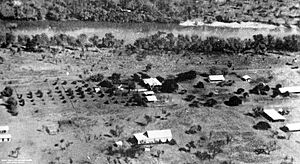Doomadgee, Queensland facts for kids
Quick facts for kids DoomadgeeQueensland |
|||||||||||||||
|---|---|---|---|---|---|---|---|---|---|---|---|---|---|---|---|
| Population | 1,387 (2021 census) | ||||||||||||||
| Postcode(s) | 4830 | ||||||||||||||
| Location | |||||||||||||||
| LGA(s) | Aboriginal Shire of Doomadgee | ||||||||||||||
| State electorate(s) | Traeger | ||||||||||||||
| Federal Division(s) | Kennedy | ||||||||||||||
|
|||||||||||||||
Doomadgee is a town and a community in Queensland, Australia. It is mostly an Indigenous community. The town is about 140 kilometers (87 miles) from the Northern Territory border. It is also about 93 kilometers (58 miles) west of Burketown.
The settlement began as the Doomadgee Mission in 1933. It later moved from Bayley Point to the Nicholson River in 1936. In 2021, the Doomadgee area had a population of 1,387 people.
Contents
History of Doomadgee
Traditional Owners of the Land
The Waanyi and Ganggalidda (Yukulta) people are the traditional owners of the land around Doomadgee. This means their ancestors have lived there for thousands of years. Other groups like the Gadawa, Lardil, Mingginda, and Garawa people also lived in or traveled through this area.
The Waanyi language is an Australian Aboriginal language spoken in this region. It covers parts of Lawn Hill Creek and Nicholson River. The Yukulta language (also called Ganggalida) is also spoken here.
European Settlement and Changes
In the late 1800s, European settlers started moving into the Doomadgee area. This had a big effect on the lives of the Indigenous peoples. There were conflicts, similar to other parts of Australia at that time.
In 1889, a group called the Native Police was set up near Doomadgee. They were known as yabayiri by local people.
In 1936, a "Protector of Aboriginals" was appointed. This person had control over the lives of Aboriginal and Torres Strait Islander people in Queensland. This system changed in 1966.
The Doomadgee Mission (1933–1983)
The Doomadgee Mission started in 1933 at Bayley Point. It was first called Dumaji. It was set up by Len and Dorothy Akehurst, who were members of a Christian group called the Open Brethren. They had a home for Aboriginal children in Burketown, which they moved to the new mission site. Most people who came to the mission were Gangalidda and Garawa people from Burketown.
At first, girls lived in a house and boys in tents. Later, separate buildings called dormitories were built for them. The Akehursts left in 1935.
In 1936, a strong storm called a cyclone damaged the mission. So, the community and dormitories moved to a new location on the Nicholson River. This new place became known as "New Doomadgee."
The number of people at the mission grew in the 1930s and 1940s. This was because the Queensland Government moved many Aboriginal families from nearby cattle stations to the mission. Official records show that over 80 people were moved between 1935 and 1957.
The mission had a hospital, a school, and even a cattle farm and a garden. However, reports from 1949 and 1950 said there was no proper school building. Lessons took place in the dormitories.
Life at the mission was closely watched. People had to follow a Christian way of life. Children over six years old lived in the dormitories. Boys usually left around age 14 to work on stations. Girls were trained for housework and often stayed in dormitories until they married.
By the late 1950s, some residents started leaving. They moved to the Mornington Island mission, where families could stay together. In 1958, about 115 children aged 6–20 were living at Doomadgee Mission.
In the 1960s, some older girls began returning to their families. The Queensland Government took over the mission's management from the Brethren in 1983. It is not clear exactly when the last children left the dormitories.
Today, two dormitory buildings still stand: the girls' dormitory and the boys' dormitory. One dormitory was destroyed by fire in 2003.
Recent Times
The Doomadgee Post Office opened on January 2, 1969.
In January 2007, the Doomadgee Aboriginal Council became the Doomadgee Aboriginal Shire Council. This meant it gained full local government status.
Population of Doomadgee
Doomadgee is mainly an Indigenous community.
- In 2011, the town of Doomadgee had 1,258 people.
- In 2016, the Doomadgee area had 1,405 people.
- In 2021, the Doomadgee area had 1,387 people.
How Doomadgee is Governed
On May 21, 1987, the land where the mission was located was given to the Doomadgee Aboriginal Council. This was done under a special agreement called a Deed of Grant in Trust (DOGIT). This meant the Aboriginal Council became the trustee of the land.
On January 1, 2005, the Doomadgee Aboriginal Council officially became the Doomadgee Aboriginal Shire Council. This council now manages the local government area of Doomadgee.
Education in Doomadgee
Doomadgee State School is a government school for students from early childhood (like Prep) up to Year 10. It is located on Goodeedawa Road. In 2017, the school had 325 students. It also has a special education program.



